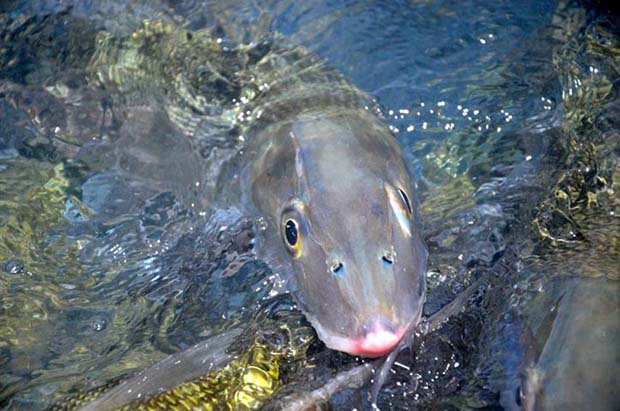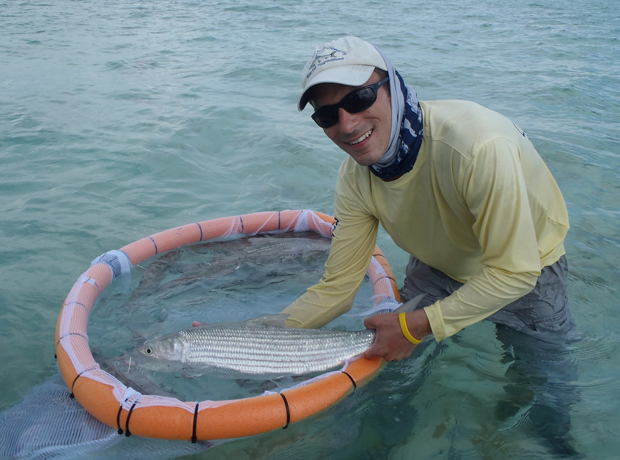By Zack Jud / Bonefish & Tarpon Trust
[dropcap]L[/dropcap]ast month, Bonefish and Tarpon Trust’s Bahamas Initiative waded into the fabled waters of South Andros. While a handful of bonefish had previously been tagged by guides in South Andros, this was the first large-scale tagging effort on the island. As most anglers probably know, catching a tagged bonefish (or any tagged fish for that matter!) is a once in a lifetime experience. From a research perspective, the more fish we have tagged in a given locale, the more likely we are to get valuable data from recaptures – data that we will use to identify growth rates, movement patterns, habitat use, and overall health of the area’s bonefish population.
Despite a lingering cold front and 25 knot winds, the BTT-led research team managed to tag more than 650 bonefish in four long days on the water. To even their odds in the face of ugly weather, the team reluctantly set down their fly rods (well, for the most part), and instead relied on a 250’ long soft mesh seine net to capture bonefish for tagging. Working closely with guides from Deneki’s Andros South Lodge, the researchers used the net to quietly encircle large, and oftentimes fast-moving, schools of bonefish. Unfortunately, herding bonefish into a net is a bit like herding cats…they rarely go where you want them to. All too often, a school will make a last-minute U-turn, slipping right back out of the closing net. To put the odds in their favor, the BTT team asked the guides to try to find the largest schools of bonefish possible, figuring that with enough fish in the water, they’d be bound to get a few to swim into the net. Well, the guides clearly know their fishery intimately, putting the researchers onto many huge schools of bonefish, some containing more than 1,000 fish. Worries about catching enough fish during the trip were quickly replaced by worries about running out of tags!
In the first day of tagging, a single net haul resulted in the capture of more than 400 fish (not counting several hundred more fish that managed to stay out of the net as the big school split in half). On day two, in the midst of a raging lightning storm, the team again managed to capture a huge school of bonefish, probably numbering close to 500 fish. Facing fading light and a long, rainy run back to the dock, the crew made the tough decision to call it a day before they had tagged the entire school. They ended up releasing several hundred untagged fish so they could make it home before dark. There’s just that many bonefish in South Andros! Rapidly deteriorating weather reduced the number of fish caught on the last two days of the trip, but the crew still managed to tag fish in all of the popular South Andros fishing spots – Grassy and Little Creeks, the west side, and the southern cays. We don’t want to tell a fish story, but there are some awfully big fish swimming around South Andros wearing a new piece of numbered jewelry, courtesy of BTT.
On BTT research trips, the work doesn’t stop when the boats are parked and the nets are out of the water. An important part of these trips is explaining BTT’s conservation efforts to local guides and lodge owners. Without the continued support of these folks, our work wouldn’t be possible. I am happy to report that our efforts to protect Andros’ bonefish into the future were very well received, and all of the guides and lodges in South Andros seem eager to report recaptures back to BTT. With the busy season cranking up, it’s only a matter of time before clients begin catching our tagged fish. Despite the economic value of the bonefish fishery on Andros, we still have many unanswered questions about the fish that call the island home. How big of an area do these fish use during their life? How quickly do they grow? Where do they spawn? What habitats are most important for the conservation of the species? What do we need to do to assure that the incredible South Andros fishery is protected for years to come? Although it will still be some time before significant numbers of recaptures start rolling in, the work we began last month is the first step in coming up with answers to these important conservation questions. To become a member or support our efforts in the Bahamas or support any of our other great projects.
To visit BTT website click here […]



